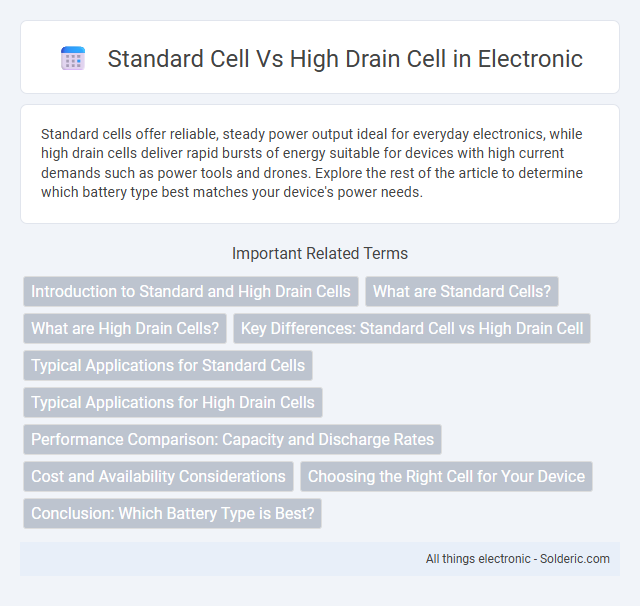Standard cells offer reliable, steady power output ideal for everyday electronics, while high drain cells deliver rapid bursts of energy suitable for devices with high current demands such as power tools and drones. Explore the rest of the article to determine which battery type best matches your device's power needs.
Comparison Table
| Feature | Standard Cell | High Drain Cell |
|---|---|---|
| Discharge Rate (Continuous) | Up to 5A | Often exceeds 10A |
| Capacity | Higher mAh capacity | Moderate to high mAh capacity |
| Use Case | Low-drain devices (e.g., remotes, clocks) | High-drain devices (e.g., power tools, vaping devices) |
| Internal Resistance | Higher internal resistance | Low internal resistance for better current delivery |
| Cycle Life | Longer cycle life under low load | Shorter cycle life at high current draw |
| Price | Generally lower cost | Typically higher cost |
Introduction to Standard and High Drain Cells
Standard cells are designed to provide a steady current output suitable for everyday electronic devices, featuring moderate capacity and typical discharge rates. High drain cells deliver significantly higher current bursts required by power-intensive gadgets like digital cameras and high-performance flashlights, often at the cost of reduced overall capacity. Battery chemistry and construction differences optimize standard cells for longevity, while high drain cells focus on rapid energy discharge without compromising safety.
What are Standard Cells?
Standard cells are lithium-ion batteries designed for moderate, consistent energy output, making them ideal for everyday devices like smartphones and laptops. These cells offer balanced capacity and stable voltage, ensuring reliable performance during typical usage. Your choice of a standard cell supports efficiency and longevity in regular applications without the need for rapid, high-energy discharge.
What are High Drain Cells?
High drain cells are specialty batteries designed to deliver a continuous high current output without significant voltage drop, ideal for devices like power tools, vaping mods, and high-performance flashlights. Unlike standard cells, which prioritize energy capacity and longevity, high drain cells maintain stable voltage under heavy load due to their lower internal resistance and superior chemistries, typically lithium-ion or lithium polymer. These batteries are engineered for rapid discharge rates, often exceeding 10 amps, ensuring reliable performance in demanding electronic applications.
Key Differences: Standard Cell vs High Drain Cell
Standard cells prioritize energy density and long-lasting performance, making them ideal for low to moderate power devices like remote controls and clocks. High drain cells deliver rapid bursts of high current, suitable for power-hungry gadgets such as digital cameras and gaming controllers. The key difference lies in their internal construction: standard cells use thicker electrodes for stable capacity, while high drain cells feature enhanced electrolyte and thinner electrodes to support high current discharge without voltage drop.
Typical Applications for Standard Cells
Standard cells are commonly used in general consumer electronics, such as remote controls, clocks, and flashlights, where moderate current drain and longer battery life are essential. These cells suit devices with intermittent or low power usage, providing reliable performance at a lower cost compared to high drain cells. Their widespread application in portable gadgets highlights their balance between energy efficiency and affordability.
Typical Applications for High Drain Cells
High drain cells are specifically designed for devices requiring bursts of high current, such as power tools, digital cameras, and high-performance flashlights. These batteries maintain voltage under heavy load, ensuring consistent performance in demanding applications. Your devices will benefit from improved efficiency and longer run times when powered by high drain cells.
Performance Comparison: Capacity and Discharge Rates
High drain cells provide superior performance in applications requiring rapid energy delivery, offering higher discharge rates compared to standard cells that prioritize capacity over output speed. Standard cells typically have greater milliampere-hour (mAh) capacity, making them suitable for longer-duration, lower-drain devices, while high drain batteries excel in power-intensive electronics like power tools and high-performance flashlights. Your choice between these batteries should balance the need for sustained energy capacity and the ability to handle high current draws effectively.
Cost and Availability Considerations
Standard cells generally offer lower costs due to widespread manufacturing and economies of scale, making them readily available for most consumer electronics. High drain cells, designed for devices with intense power demands such as digital cameras and power tools, tend to be more expensive owing to specialized materials and enhanced performance specifications. Availability of high drain cells can be limited compared to standard cells, as they cater to niche markets requiring sustained high current output.
Choosing the Right Cell for Your Device
Selecting between a standard cell and a high drain cell depends on your device's power requirements and usage patterns. Standard cells offer long-lasting energy suitable for low-drain devices like remote controls and clocks, while high drain cells deliver a rapid, continuous burst of power ideal for high-performance gadgets such as digital cameras and gaming controllers. Understanding the current draw and device specifications ensures optimal battery life and performance by matching the cell type to your device's demands.
Conclusion: Which Battery Type is Best?
High drain cells offer superior performance in devices requiring rapid bursts of power, such as digital cameras and power tools, due to their higher current output and lower internal resistance. Standard cells are more cost-effective for low-drain applications like remote controls and clocks, providing longer shelf life and stable voltage. Choosing the best battery type depends on the specific energy demands of the device, with high drain cells optimal for high-power usage and standard cells suited for continuous, low-power consumption.
Standard cell vs high drain cell Infographic

 solderic.com
solderic.com